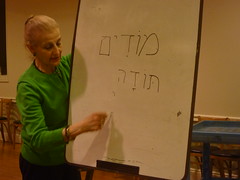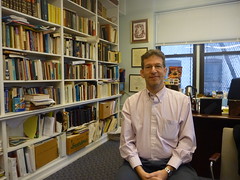 Hannah Rubenstein Carol Green, a religious instructor at the Town and Village Synagogue, teaches Hebrew to a group of adult bat mitzvah students. Although becoming a bar or bat mitzvah as an adult is hardly novel, the synagogue’s program is distinct because its participants undergo the ceremony as a group rather than independently.
Hannah Rubenstein Carol Green, a religious instructor at the Town and Village Synagogue, teaches Hebrew to a group of adult bat mitzvah students. Although becoming a bar or bat mitzvah as an adult is hardly novel, the synagogue’s program is distinct because its participants undergo the ceremony as a group rather than independently.In the basement of the synagogue on a windy Monday evening, a group of students hunch over prayer books, tracing ancient words from right to left with the tips of their fingers. At the end of the table, a woman stands at a whiteboard, writing large letters in careful, deliberate strokes. Because this is a beginning Hebrew class, the progress is halting. But the students are focused. No one glances around the room or shifts in her seat. Together, slowly, their voices chant:
“Baruch atah Adonai… elohaynu melech ha’olam… asher kidshanu… bemitzvotav vetzivanu… l’hadlik ner… shel Shabbat.”
After the last syllable fades away, the teacher breaks into a wide smile. At this rate, the students will surely be ready when the time comes to stand at the bimah and read the Torah in front of the whole congregation. Years of study have prepared them to become bat mitzvahs, to be recognized and welcomed into the Jewish faith as independent adults.
There is only one difference between these students and others around the world studying to become bar and bat mitzvahs — these are not boys and girls, nervously approaching their 13th and 12th birthdays, respectively. These are women between the ages of 20 and 80. This bat mitzvah class is for adults only.
In Jewish tradition, children become bar or bat mitzvahs (sons or daughters of the commandment) during puberty. The ceremony, which requires several years of intense training, involves standing before the congregation to read the Torah, a Haftarah portion, or both at a Shabbat or other service when the Torah is read, and may also involve giving a d’var Torah, a discussion of that week’s Torah portion. The service often precedes a celebratory meal with family, friends, and members of the community.
Rabbi Laurence A. Sebert, who is the spiritual leader of the conservative Town and Village Synagogue at 14th Street between First and Second Avenues in the East Village, decided to begin offering an adult bar and bat mitzvah class to his congregation two years ago. Although becoming a bar or bat mitzvah as an adult is not a new phenomenon — the Rabbi recalls witnessing a great increase in adult bar mitzvahs more than two decades ago — Rabbi Sebert wanted to do things differently. Whereas most individuals undergoing the ceremony as adults have done so independently, the Rabbi wanted to re-create the rituals that 12- and 13-year-olds experience as members of a close community working toward the same goal.
“The community of the class and the sense of being part of the larger community is what draws people to the program,” said Rabbi Sebert, sitting in his office where books were stacked from floor to ceiling. Especially for those who convert to Judaism, he said, “the sense of being an outsider sometimes lingers.”
“The class reinforces a personal sense of belonging,” he added.
 Hannah Rubenstein Rabbi Laurence A. Sebert, who leads the Town and Village Synagogue at 14th Street between First and Second Avenues in the East Village, decided to begin offering an adult bar and bat mitzvah class to his congregation two years ago. “The class reinforces a personal sense of belonging,” he said.
Hannah Rubenstein Rabbi Laurence A. Sebert, who leads the Town and Village Synagogue at 14th Street between First and Second Avenues in the East Village, decided to begin offering an adult bar and bat mitzvah class to his congregation two years ago. “The class reinforces a personal sense of belonging,” he said.For Natalya Vinokurova, a 31-year-old doctoral student at NYU, becoming bat mitzvah will be the culmination of generations of her family fighting for acceptance. Ms. Vinokurova was born in Minsk and emigrated to the United States at age 15.
“When I was growing up, I always thought of myself as being Jewish,” she explained. Although her parents were self-declared atheists, Ms. Vinokurova believed that her Jewish identity was as much cultural as religious.
“My Mom makes the same gefilte fish that my ancestors ate,” she said by way of explanation.
But Judaism was more than just a sense of cultural affinity: Ms. Vinokurova’s grandfather was the only member of his immediate family to survive the Holocaust during the Second World War. To Ms. Vinokurova, becoming bat mitzvah is a symbolic gesture towards the millions of victims who perished as a result of their faith.
“For me,” she said, her eyes glazed with tears, “Jewish practice is this idea that Hitler did not succeed.”
For other women in the class, the choice to become bat mitzvah is based on a variety of reasons: adult conversion to the religion, inability to undergo the ceremony due to age (women weren’t allowed to become bat mitzvahs until the 1950’s and are still banned from doing so in certain congregations), or a desire to become more educated in Jewish customs.
Marianne Mott Newrith, a 46-year-old mother of two, is a convert to Judaism. When her son was two years old, she experienced what she recalled as an “a-ha” moment.
Suddenly, she realized, “I wanted to be Jewish and raise a Jewish family.” Becoming bat mitzvah 13 years later is her way of engrossing herself more fully in the faith.
All 15 women in the class — there were several men in the beginning who dropped out due to scheduling conflicts and illness — are planning on participating in a group ceremony next June to complete the ritual and become, in the eyes of the congregation, official adults in the Jewish community. Some of the women have expressed interest in participating in an individual ceremony, as well.
But, among this diverse group of students, one element of the ceremony has unanimous support:
“There won’t be a DJ or pony rides,” Ms. Vinokurova laughed.



